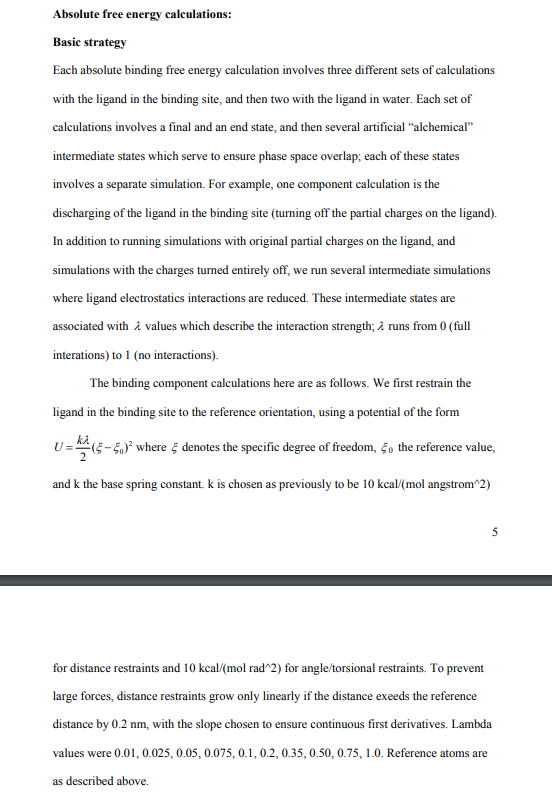Date: Wed, 15 Jul 2020 21:50:24 +0000
Dear Amber users
I found a paper on absolute free energy methods referenced https://doi.org/10.1016/j.jmb.2009.09.049
In the Supplementary info section, I found this paragraph. I am trying to understand two things (1)how to implement angle, torsional restraints in AMBER18.
Also the last line of the paragraph says “To prevent large forces...exceeds the distance by 0.2 nM with the slope...” (2) how do we fine tune the ntr=1 such that our distance restraint can be linearly increased based on how far the ligand scoots out of the receptor pocket?
Anyone can help?
Thanks
Regards
[cid:image001.png.01D65ACF.7EDD49D0]
From: Debarati DasGupta<mailto:debarati_dasgupta.hotmail.com>
Sent: 06 July 2020 18:57
To: AMBER Mailing List<mailto:amber.ambermd.org>
Subject: Re: [AMBER] FW: restraint 10 kcal/mol
Hello Prof Simmerling,
Thanks for the detailed reply.
I was wondering whether FEP could remedy my problem?
All my small molecule probes ( <15 atoms) are weak binders ~-2 to -3 kcal/mol and I do not know whether there are any specific set of free energy methods that work well in such cases.
Also Prof Case suggested me to see if there is any intermediate state in the protein that allows for the ligand to decouple but at the same time not moving away too far from the initial position... I did not understand how to achieve that but seems like what you are suggesting is I should restrain the ligand and the protein residues as well in the pocket? Will that make the results meaningful?
Regards
Debarati
Sent from Mail<https://go.microsoft.com/fwlink/?LinkId=550986> for Windows 10
From: Carlos Simmerling<mailto:carlos.simmerling.gmail.com>
Sent: 06 July 2020 11:32
To: AMBER Mailing List<mailto:amber.ambermd.org>
Subject: Re: [AMBER] FW: restraint 10 kcal/mol
I have lost track a bit exactly what you're looking for... if you want to
calculate the absolute binding affinity (quite challenging in my opinion,
especially when the expected value is very small and probably within the
uncertainty of the calculation) then you can't use restraints unless you
also correct your calculated values for the use of the restraint. You might
want to look at the literature for methods, like that shown in this
tutorial https://ambermd.org/tutorials/advanced/tutorial29/index.html
My apologies if you are already doing this, as I said the thread is long
and I haven't seen all of the messages. Overall I think Dave's point is
that a positional restraint will not keep your ligand in a pocket (since
the protein can diffuse away from the ligand). You l;likely want a distance
restraint or something else involving both the protein and the ligand.
On Mon, Jul 6, 2020 at 11:16 AM Debarati DasGupta <
debarati_dasgupta.hotmail.com> wrote:
> Hello Prof Case,
> I was wondering if I missed your reply on this within so many threads on
> the list.
> Regards
>
>
> From: Debarati DasGupta<mailto:debarati_dasgupta.hotmail.com>
> Sent: 25 June 2020 09:12
> To: David A Case<mailto:david.case.rutgers.edu>
> Cc: amber.ambermd.org<mailto:amber.ambermd.org>
> Subject: Re: [AMBER] restraint 10 kcal/mol
>
> Hello Prof Case,
> Thank you for clearing out the restraint_mask functionality.
> SO does that mean, in the bigger picture, whatever I did to set up my
> absolute binding free energy calculations is totally wrong?
> Using a co-solvent based approach, I have certain x,y,z locations of a set
> small molecules (ethanol, isopropanol, acetonitrile, phenol, pyridine etc)
> and I am interested to compute the absolute free energy of binding (using
> TI) of these small probes to my kinase.
> All I know is locations ( in terms of x y z coordinates) where the probe
> density is maximum, that is, places on the protein where the probe sticks
> to it.
> So, given that information, how to modify my input files so that I can set
> up TI calculations to compute free energies of binding.
> I wanted to mention these are small molecules ( all < 15 atoms) and are
> weak binders, so the range I am looking at is -1 to -3 kcal/mol roughly..
> So in your opinion how should I set up the restraint..?
> Thanks
>
> Debarati
>
>
>
>
>
>
>
> From: David A Case<mailto:david.case.rutgers.edu>
> Sent: 24 June 2020 21:36
> To: Debarati DasGupta<mailto:debarati_dasgupta.hotmail.com>
> Cc: amber.ambermd.org<mailto:amber.ambermd.org>
> Subject: Re: restraint 10 kcal/mol
>
> On Wed, Jun 24, 2020, Debarati DasGupta wrote:
>
> > ntr=1, restraintmask=':EOH', restraint_wt=10.00,
>
> Note this will keep the EOH residue from moving, but all other parts of
> the simulation are free to go where they wish. This doesn't keep the
> ligand "in the pocket"; it just keeps the xyz coordinates of the EOH
> atoms near their starting point. Basically, all this will do is to
> ensure that internal geometry of EOH is kept fixed. I doubt that is
> really what you wanted to do: since ethanol is rather rigid anyway, this
> is almost like having no restraint at all.
>
> >So, after the run was complete, I was curious to see how far my ligand
> >has translated from its tether point.. and after doing a COM distance
> >cpptraj script run, I find that for 3 lambda values 0.11505, 0.20634,
> >and 0.31608; the ligand has moved around quite a bit as in > 3 Angstroms
>
> It's not at all clear what you mean by a "COM distance cpptraj script";
> but I hope the explanation of the restraint mask above will help.
>
> ....dac
>
> _______________________________________________
> AMBER mailing list
> AMBER.ambermd.org
> http://lists.ambermd.org/mailman/listinfo/amber
>
> _______________________________________________
> AMBER mailing list
> AMBER.ambermd.org
> http://lists.ambermd.org/mailman/listinfo/amber
>
_______________________________________________
AMBER mailing list
AMBER.ambermd.org
http://lists.ambermd.org/mailman/listinfo/amber
_______________________________________________
AMBER mailing list
AMBER.ambermd.org
http://lists.ambermd.org/mailman/listinfo/amber
_______________________________________________
AMBER mailing list
AMBER.ambermd.org
http://lists.ambermd.org/mailman/listinfo/amber

(image/png attachment: 06F41C44C404403EB9642A0283594FE9.png)
